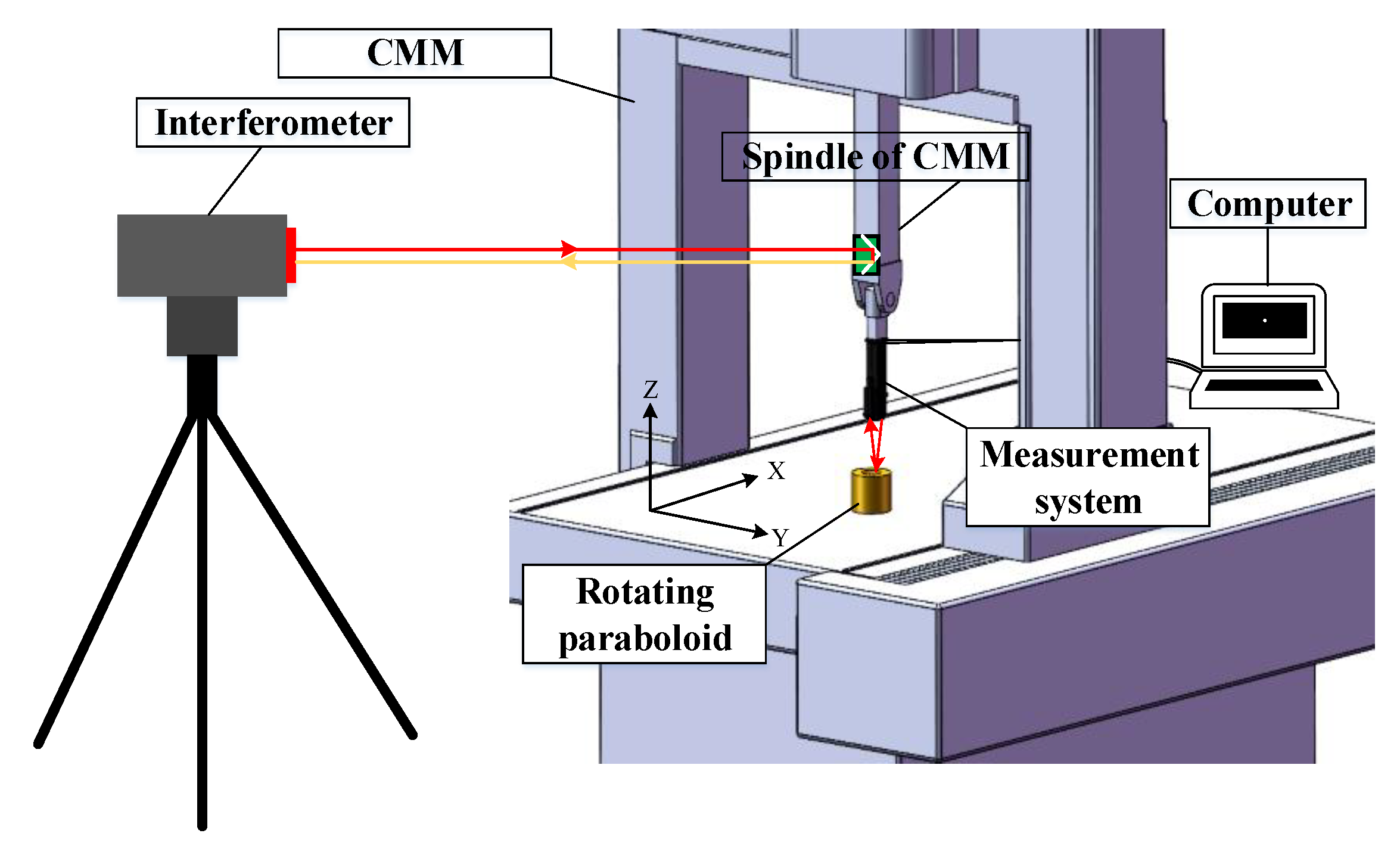A Novel 2D Micro-Displacement Measurement Method Based on the Elliptical Paraboloid
Abstract
:1. Introduction
2. System and Principle
2.1. System Configuration
2.2. Measurement Principle
2.3. Light Spot Image Processing
3. Experimental Results
3.1. Calibration Experiments
3.2. Comparison Experiments
4. Discussion
4.1. Manufacturing Error of the Elliptical Paraboloid
4.2. Other Errors
4.3. Future Research
5. Conclusions
Author Contributions
Funding
Conflicts of Interest
References
- Tan, X.R.; Zhu, F.; Wang, C.; Yu, Y.; Shi, J.; Qi, X.; Yuan, F.; Tan, J.B. Two-Dimensional Micro-/Nanoradian Angle Generator with High Resolution and Repeatability Based on Piezo-Driven Double-Axis Flexure Hinge and Three Capacitive Sensors. Sensors 2017, 17, 2672. [Google Scholar] [Green Version]
- Jywe, W.Y.; Hsieh, T.H.; Chen, P.Y.; Wang, M.S. An Online Simultaneous Measurement of the Dual-Axis Straightness Error for Machine Tools. Appl. Sci. 2018, 8, 2130. [Google Scholar] [CrossRef]
- Hsieh, T.H.; Chen, P.Y.; Jywe, W.Y.; Chen, G.W.; Wang, M.S. A Geometric Error Measurement System for Linear Guideway Assembly and Calibration. Appl. Sci. 2019, 9, 574. [Google Scholar] [CrossRef]
- Ikram, M.; Hussain, G. Michelson interferometer for precision angle measurement. Appl. Opt. 1999, 38, 113–120. [Google Scholar] [CrossRef] [PubMed]
- Chatterjee, S.; Kumar, Y.P. Measurement of two-dimensional small angle deviation with a prism interferometer. Appl. Opt. 2008, 47, 4900–4906. [Google Scholar] [CrossRef]
- Zhou, W.; Cai, L. Interferometer for small-angle measurement based on total internal reflection. Appl. Opt. 1998, 37, 5957–5963. [Google Scholar] [CrossRef]
- Yuan, J.; Long, X. CCD-area-based autocollimator for precision small-angle measurement. Rev. Sci. Instrum. 2003, 74, 1362–1365. [Google Scholar] [CrossRef]
- Chen, Y.T.; Huang, Y.S.; Liu, C.S. An Optical Sensor for Measuring the Position and Slanting Direction of Flat Surfaces. Sensors 2016, 16, 1061. [Google Scholar] [CrossRef]
- Heikkinen, V.; Byman, V.; Palosuo, I. Interferometric 2D small angle generator for autocollimator calibration. Metrologia 2017, 54, 253–261. [Google Scholar] [CrossRef] [Green Version]
- Liu, Y.; Kuang, C.; Ku, Y. Small angle measurement method based on the total internal multi-reflection. Opt. Laser Technol. 2012, 44, 1346–1350. [Google Scholar] [CrossRef]
- Li, K.; Kuang, C.; Liu, X. Small angular displacement measurement based on an autocollimator and a common-path compensation principle. Rev. Sci. Instrum. 2013, 84, 015108. [Google Scholar] [CrossRef] [PubMed]
- Martincek, I.; Kacik, D. A PDMS microfiber Mach-Zehnder interferometer and determination of nanometer displacements. Opt. Fiber Technol. 2018, 40, 13–17. [Google Scholar] [CrossRef]
- Lee, J.; Park, S.; Seo, D.H. Displacement measurement using an optoelectronic oscillator with an intra-loop Michelson interferometer. Opt. Express 2016, 24, 21910. [Google Scholar] [CrossRef] [PubMed]
- Wang, S.; Chiu, M.; Chen, W. Small-displacement sensing system based on multiple total internal reflections in heterodyne interferometry. Appl. Opt. 2009, 48, 2566–2573. [Google Scholar] [CrossRef] [PubMed]
- Lin, J.L.; Lee, X.X.; Hsieh, M.C.; Chang, C.O. High-angular-sensitivity total-internal-reflection heterodyne interferometry for micro-displacement measurements. Sens. Actuators A Phys. 2018, 277, 163–168. [Google Scholar] [CrossRef]
- Hsu, C.; Chen, H.; Tseng, H.; Lan, S.; Lin, J. High displacement resolution encoder by triple grating combination interferometer. Opt. Laser Technol. 2018, 105, 221–228. [Google Scholar] [CrossRef]
- Ku, Y.; Kuang, C.; Luo, D. Differential internal multi-reflection method for nano-displacement measurement. Opt. Lasers Eng. 2012, 50, 1445–1449. [Google Scholar] [CrossRef]
- Gao, W.; Dejima, S.; Shimizu, Y.; Kiyono, S. Precision Measurement of Two-Axis Position and Tilt Motions Using a Surface Encoder. CIRP Ann.-Manuf. Technol. 2013, 52, 435–438. [Google Scholar] [CrossRef]
- Fang, F.Z.; Zhang, X.D.; Weckenmann, A.; Zhang, G.X.; Evans, C. Manufacturing and Measurement of Freeform Optics. CIRP Ann.-Manuf. Technol. 2013, 62, 823–846. [Google Scholar] [CrossRef]
- Gao, W.; Araki, T.; Kiyono, S. Precision nano-fabrication and evaluation of a large area sinusoidal grid surface for a surface encoder. Precis. Eng. 2003, 27, 289–298. [Google Scholar] [CrossRef]
- Gao, W.; Kimura, A. A Three-axis Displacement Sensor with Nanometric Resolution. CIRP Ann.-Manuf. Technol. 2007, 56, 529–532. [Google Scholar] [CrossRef]












| Parabola | Quadratic Coefficient | First-Order Coefficients | Constant Term |
|---|---|---|---|
| 1 | 0.003157 | –38.4374 | 1.1681 |
| 2 | 0.003157 | –39.3118 | 1.2224 |
| 3 | 0.003160 | –35.9953 | 1.0234 |
| 4 | 0.003158 | –36.7723 | 1.2039 |
© 2019 by the authors. Licensee MDPI, Basel, Switzerland. This article is an open access article distributed under the terms and conditions of the Creative Commons Attribution (CC BY) license (http://creativecommons.org/licenses/by/4.0/).
Share and Cite
Lv, Z.; Li, X.; Su, Z.; Zhang, D.; Yang, X.; Li, H.; Li, J.; Fang, F. A Novel 2D Micro-Displacement Measurement Method Based on the Elliptical Paraboloid. Appl. Sci. 2019, 9, 2517. https://doi.org/10.3390/app9122517
Lv Z, Li X, Su Z, Zhang D, Yang X, Li H, Li J, Fang F. A Novel 2D Micro-Displacement Measurement Method Based on the Elliptical Paraboloid. Applied Sciences. 2019; 9(12):2517. https://doi.org/10.3390/app9122517
Chicago/Turabian StyleLv, Zekui, Xinghua Li, Zhikun Su, Dong Zhang, Xiaohuan Yang, Haopeng Li, Jue Li, and Fengzhou Fang. 2019. "A Novel 2D Micro-Displacement Measurement Method Based on the Elliptical Paraboloid" Applied Sciences 9, no. 12: 2517. https://doi.org/10.3390/app9122517





